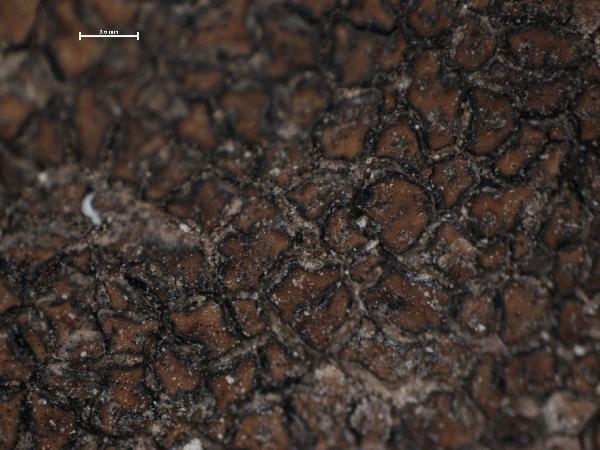Acarospora scotica Hue
Nouv. Arch. Mus. Hist. Nat., Paris, 5, sér. 1: 147, 1909.
Synonyms:
Distribution: N - Lomb (S-F99329, De Vita & Valcuvia 2004), Piem (Valcuvia 2002, 2002b), Emil (TSB 35572), Lig (GDOR 1020). C - Tosc, Laz, Sar (Rizzi & al. 2011, Giordani & al. 2013).
Description: Thallus crustose, episubstratic, consisting of scattered to contiguous, angular, 0.3-0.8(-1) mm wide, 0.1-0.3 mm thick, epruinose, slightly concave, dark brown areoles with a raised, often wavy, black margin, forming up to 6 cm wide patches. Cortex paraplectenchymatous, (10-)30-50(-70) µm thick, mainly of anticlinally arranged hyphae, brown in upper part, colourless in lower part; algal layer more or less continuous, but usually uneven; medulla white, prosoplectenchymatous, up to 300 µm thick. Apothecia rounded, 0.1-0.5 mm across, immersed in the areoles, usually 1(-2) per areole, with a concave to flat, dark brown disc, a poorly evident thalline margin, and sometimes a concentric, thin parathecial ring. Proper exciple c. 10 µm thick; epithecium brown, c. 10 µm high; hymenium colourless, (50-)70-85(-100) µm high, I+ blue according to the original description; paraphyses coherent, (1.3-)1.5-2.1 µm thick at base, the apical cells usually not markedly expanded; subhymenium colourless or pale yellow, 15-50 µm high; hypothecium indistinct, c. 10 µm high. Asci c. 100-spored, clavate, the apical dome K/I-, 50-70 x 10-15(-25) µm. Ascospores 1-celled, hyaline, ellipsoid, (3-)4-5.5 x 1.5-1.7(-2.2) µm. Photobiont chlorococcoid. Spot tests: cortex and medulla K-, C-, KC-, P-, UV- . Chemistry: without lichen substances.Note: a probably Mediterranean-Atlantic species of siliceous rocks wetted by rain, reaching the montane belt in dry-continental areas (e.g. in the Alps).
Growth form: Crustose
Substrata: rocks
Photobiont: green algae other than Trentepohlia
Reproductive strategy: mainly sexual
Commonnes-rarity: (info)
Alpine belt: absent
Subalpine belt: absent
Oromediterranean belt: absent
Montane belt: absent
Submediterranean belt: extremely rare
Padanian area: absent
Humid submediterranean belt: extremely rare
Humid mediterranean belt: extremely rare
Dry mediterranean belt: very rare

Predictive model
Herbarium samples

United States National Herbarium - Smithsonian (US:Lichens) - Collector: W. A. Weber
Number: S 8495 Locality: United States, Colorado, Boulder, Mouth of Gregory Canyon, foothills of Front Range just W of Boulder. Elevation: 1829 meters (5999ft) - CC BY-NC 3.0 - Source: Consortium of Lichen Herbaria (2023) http//:lichenportal.org/portal/index.php. Accessed on December 14.
Growth form: Crustose
Substrata: rocks
Photobiont: green algae other than Trentepohlia
Reproductive strategy: mainly sexual
Commonnes-rarity: (info)
Alpine belt: absent
Subalpine belt: absent
Oromediterranean belt: absent
Montane belt: absent
Submediterranean belt: extremely rare
Padanian area: absent
Humid submediterranean belt: extremely rare
Humid mediterranean belt: extremely rare
Dry mediterranean belt: very rare

Predictive model
| Herbarium samples |

 INDEX FUNGORUM
INDEX FUNGORUM
 GBIF
GBIF



